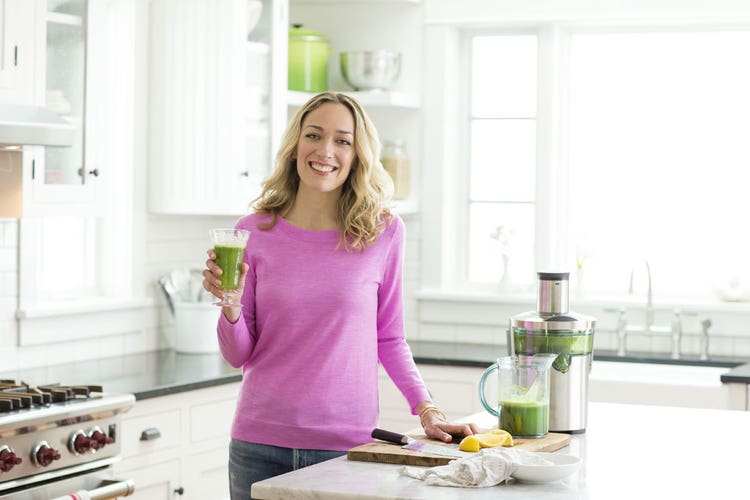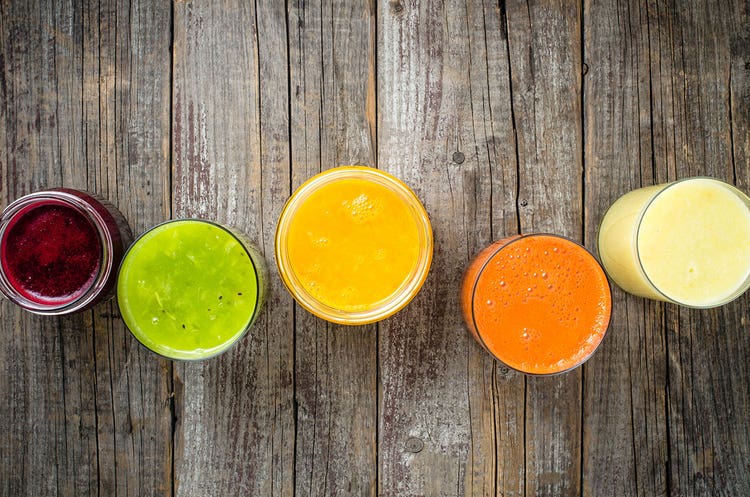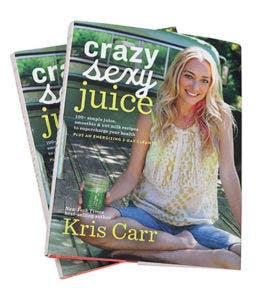Nourishment, According to Kris Carr

The cancer survivor and New York Times best-selling author defines it on crazy, sexy terms.
When Kris Carr learned that she had cancer in 2003, she changed her life—and decided to inspire others to do the same. The wellness advocate has since authored five books, including “Crazy Sexy Diet,” “Crazy Sexy Kitchen,” “Crazy Sexy Cancer Tips,” “Crazy Sexy Cancer Survivor,” and her newest, “Crazy Sexy Juice.” We recently spoke to Carr about the largely-plant-based, nutrient-dense, whole-foods diet that nourishes her. Read on for our Q&A, plus a delicious recipe from “Crazy Sexy Juice.”

Q: When were you diagnosed with cancer, and how did that diagnosis affect your life?
Kris Carr (KC): I was diagnosed with a rare and incurable, stage IV cancer out of the blue. At the time, I was 31 years old, living in New York City in a very different and hectic life. Everything changed once I got the news. I dumped the city and my job and got back to basics. I also went on an inner pilgrimage to learn how to care for and honor myself. It was a big wake-up call that led to profound and important shifts.
Q: Were you initially resistant to making life changes to boost your health?
KC: Not at all. Because there’s no treatment for my disease, I wanted to help my body out. I wanted to participate in my wellness instead of my illness. But I’m pretty lucky because the cancer I have can be slow growing or aggressive. Currently, I have the slow-growing type, but that can change. So I get tested every two years, and in between, I do my best to live my life to the fullest and take care of myself.
Q: How did you change your diet?
KC: I did a ton of research (and still do), and chose to follow a plant-based, healing diet. It’s antiinflammatory, low in sugar, and high in nutrients and phytochemicals. For cancer patients, and anyone interested in prevention or just feeling better overall, it’s a smart choice.
Q: How would you describe your typical day of meals?
KC: A typical day starts with a green juice and oatmeal or avocado toast or a healthy smoothie filled with good fats. For lunch, I’ll have something like a bean burrito or hummus wrap or tempeh TLT (the vegan version of a BLT, but no pigs were harmed and it’s good for you). I’ll follow that with soup and salad or a quinoa bowl filled with plant-based protein, veggies and a delicious sauce for dinner. I also drink lots of water throughout the day and stay away from processed foods, chemicals, soda, and fake stuff. My advice: If it’s made in a lab, it takes a lab to digest. And if it has a shelf life longer than you, don’t eat it! What you put in your body matters; don’t skimp on yourself.
Q: How do you motivate yourself to stick to your diet?
KC: Because I feel so much better and love this way of eating and living so much, it’s not something I think of as needing to stick to. Also, I’m not hard on myself. I focus on progress, not perfection. Birthday cakes happen––thank God!
Q: How much do you credit your dietary changes for your health?
KC: I feel so much better and hope that my choices make a difference for my well-being. I am pretty certain they do. You should have seen what my diet and lifestyle used to look like before cancer. Garbage and stress in, poor health and limited happiness out.
Q: Do you feel that some foods are universally healthy or harmful?
KC: Of course! I consider processed and refined foods and too many animal products (especially from factory farms that abuse animals and pump them with antibiotics) harmful. From birth to death, it matters how animals are treated. It matters to them, the environment and your health.
And we can’t forget to talk about pesticides. They mess with our hormones, immunity and well-being. Take apples, for example. They’re some of the most highly contaminated fruits, which lands them right at the top of the Environmental Working Group’s Dirty Dozen (a list of the most highly contaminated produce). In tests done by Pesticide Action Network, 42 different pesticides were found on conventionally grown apples. Of those 42, 10 were known neurotoxins and seven were carcinogenic. Throw an apple in your green juice every day, and the number of toxins entering your system multiplies at centrifugal speed. Now multiply that number because we certainly eat more than an apple a day to keep the doctor away.
Also, it’s not just what you put on your plate that matters. It’s also what you put on your body and surround yourself with. (Hello, skin care and cleaning products––I’m talking to you!)
But don’t let any of this overwhelm you. You don’t have to change everything all at once; it’s a process. And with a little knowledge and dedication, we can be empowered consumers dedicated to making our inner and outer worlds more vibrant and sustainable.
Q: What is your best advice for determining which foods will heal or harm?
KC: Get back to basics and back to the garden. Learn to love veggies. They’re amazing when you know how to cook them. And trust me, it’s easy!
BLOAT BUSTER

Yield: 2 Servings
- 6 leaves dandelion greens
- 1 large cucumber
- 2 large leaves Swiss chard
- 1/8 cup parsley, leaves and stems, tightly packed
- 2 cups honeydew melon cubes
- Wash and prep all ingredients.
- Juice all ingredients.
Photo credit: Bill Miles (hero, book cover); LeszekCzerwonka, Adobe Stock